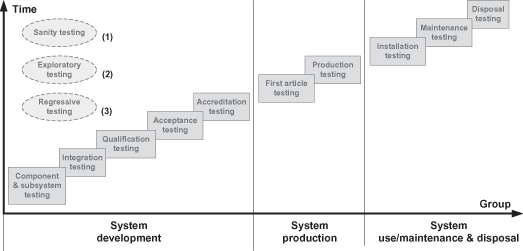5.7 BLACK BOX—PHASE TESTING
Figure 5.38 depicts a typical set of testing activities distributed along a system’s lifetime. Please note that sanity, exploratory and regression testing are performed throughout the system lifetime and are not specifically associated with any particular lifecycle.
Figure 5.38 Testing activities distribution along a typical system lifetime.

5.7.1 Sanity Testing
Purpose
Sanity testing is a rudimental testing process. The purpose is to evaluate quickly the general validity of a performance claim or the overall functionality of a system. In other words, to assure that a system or methodology works, in general, as expected.
Rationale
Sanity testing, sometime called “smoke testing,” is usually carried out prior to a more exhaustive round of testing at different levels of testing granularity (i.e., component, subsystem, system and system of systems levels). The rationale here is to perform cursory, fast and inexpensive testing, sufficient to show that the SUT is functioning reasonably well.
Method
Sanity testing is similar in many respects to exploratory testing. It is an ad hoc and unscripted type of testing where the discovery or unexpected system behavior triggers further exploration and testing.
For example, a hardware engineer builds a new electronics board, connects it to its appropriate power source and checks first that the unit does not overheat ...
Get Verification, Validation, and Testing of Engineered Systems now with the O’Reilly learning platform.
O’Reilly members experience books, live events, courses curated by job role, and more from O’Reilly and nearly 200 top publishers.

